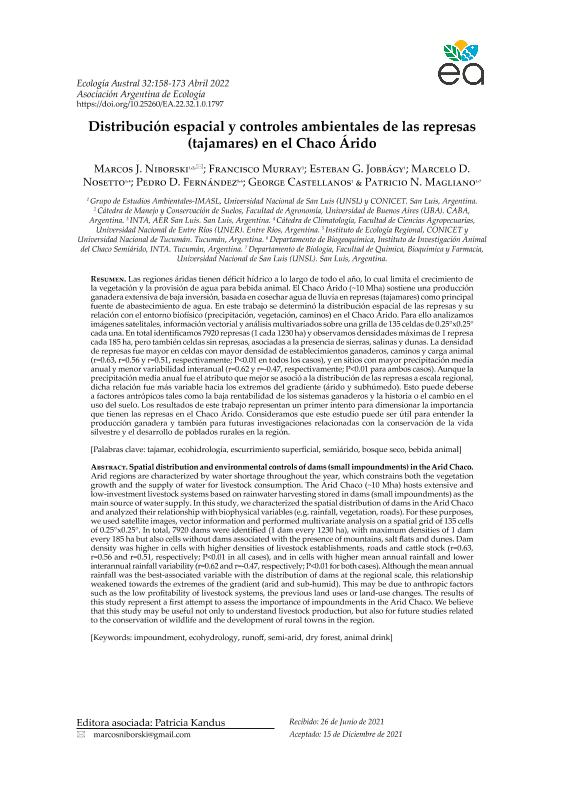Artículo
Las regiones áridas tienen déficit hídrico a lo largo de todo el año, lo cual limita el crecimiento de la vegetación y la provisión de agua para bebida animal. El Chaco Árido (~10 Mha) sostiene una producción ganadera extensiva de baja inversión, basada en cosechar agua de lluvia en represas (tajamares) como principal fuente de abastecimiento de agua. En este trabajo se determinó la distribución espacial de las represas y su relación con el entorno biofísico (precipitación, vegetación, caminos) en el Chaco Árido. Para ello analizamos imágenes satelitales, información vectorial y análisis multivariados sobre una grilla de 135 celdas de 0.25°x0.25° cada una. En total identificamos 7920 represas (1 cada 1230 ha) y observamos densidades máximas de 1 represa cada 185 ha, pero también celdas sin represas, asociadas a la presencia de sierras, salinas y dunas. La densidad de represas fue mayor en celdas con mayor densidad de establecimientos ganaderos, caminos y carga animal (r=0.63, r=0.56 y r=0.51, respectivamente; P<0.01 en todos los casos), y en sitios con mayor precipitación media anual y menor variabilidad interanual (r=0.62 y r=-0.47, respectivamente; P<0.01 para ambos casos). Aunque la precipitación media anual fue el atributo que mejor se asoció a la distribución de las represas a escala regional, dicha relación fue más variable hacia los extremos del gradiente (árido y subhúmedo). Esto puede deberse a factores antrópicos tales como la baja rentabilidad de los sistemas ganaderos y la historia o el cambio en el uso del suelo. Los resultados de este trabajo representan un primer intento para dimensionar la importancia que tienen las represas en el Chaco Árido. Consideramos que este estudio puede ser útil para entender la producción ganadera y también para futuras investigaciones relacionadas con la conservación de la vida silvestre y el desarrollo de poblados rurales en la región. Arid regions are characterized by water shortage throughout the year, which constrains both the vegetation growth and the supply of water for livestock consumption. The Arid Chaco (~10 Mha) hosts extensive and low-investment livestock systems based on rainwater harvesting stored in dams (small impoundments) as the main source of water supply. In this study, we characterized the spatial distribution of dams in the Arid Chaco and analyzed their relationship with biophysical variables (e.g. rainfall, vegetation, roads). For these purposes, we used satellite images, vector information and performed multivariate analysis on a spatial grid of 135 cells of 0.25°x0.25°. In total, 7920 dams were identified (1 dam every 1230 ha), with maximum densities of 1 dam every 185 ha but also cells without dams associated with the presence of mountains, salt flats and dunes. Dam density was higher in cells with higher densities of livestock establishments, roads and cattle stock (r=0.63, r=0.56 and r=0.51, respectively; P<0.01 in all cases), and in cells with higher mean annual rainfall and lower interannual rainfall variability (r=0.62 and r=-0.47, respectively; P<0.01 for both cases). Although the mean annual rainfall was the best-associated variable with the distribution of dams at the regional scale, this relationship weakened towards the extremes of the gradient (arid and sub-humid). This may be due to anthropic factors such as the low profitability of livestock systems, the previous land uses or land-use changes. The results of this study represent a first attempt to assess the importance of impoundments in the Arid Chaco. We believe that this study may be useful not only to understand livestock production, but also for future studies related to the conservation of wildlife and the development of rural towns in the region.
Distribución espacial y controles ambientales de las represas (tajamares) en el Chaco Árido
Título:
Spatial distribution and environmental controls of dams (small impoundments) in the Arid Chaco
Niborski, Marcos Javier ; Murray, Francisco; Jobbagy Gampel, Esteban Gabriel
; Murray, Francisco; Jobbagy Gampel, Esteban Gabriel ; Nosetto, Marcelo Daniel
; Nosetto, Marcelo Daniel ; Fernandez, Pedro Daniel; Castellanos Garcia, George
; Fernandez, Pedro Daniel; Castellanos Garcia, George ; Magliano, Patricio Nicolás
; Magliano, Patricio Nicolás
 ; Murray, Francisco; Jobbagy Gampel, Esteban Gabriel
; Murray, Francisco; Jobbagy Gampel, Esteban Gabriel ; Nosetto, Marcelo Daniel
; Nosetto, Marcelo Daniel ; Fernandez, Pedro Daniel; Castellanos Garcia, George
; Fernandez, Pedro Daniel; Castellanos Garcia, George ; Magliano, Patricio Nicolás
; Magliano, Patricio Nicolás
Fecha de publicación:
06/2022
Editorial:
Asociación Argentina de Ecología
Revista:
Ecología Austral
ISSN:
0327-5477
Idioma:
Español
Tipo de recurso:
Artículo publicado
Clasificación temática:
Resumen
Palabras clave:
ANIMAL DRINK
,
DRY FOREST
,
ECOHYDROLOGY
,
IMPOUNDMENT
,
RUNOFF
,
SEMI-ARID
Archivos asociados
Licencia
Identificadores
Colecciones
Articulos(IER)
Articulos de INSTITUTO DE ECOLOGIA REGIONAL
Articulos de INSTITUTO DE ECOLOGIA REGIONAL
Articulos(IMASL)
Articulos de INST. DE MATEMATICA APLICADA DE SAN LUIS
Articulos de INST. DE MATEMATICA APLICADA DE SAN LUIS
Citación
Niborski, Marcos Javier; Murray, Francisco; Jobbagy Gampel, Esteban Gabriel; Nosetto, Marcelo Daniel; Fernandez, Pedro Daniel; et al.; Distribución espacial y controles ambientales de las represas (tajamares) en el Chaco Árido; Asociación Argentina de Ecología; Ecología Austral; 32; 1; 6-2022; 158-173
Compartir
Altmétricas



